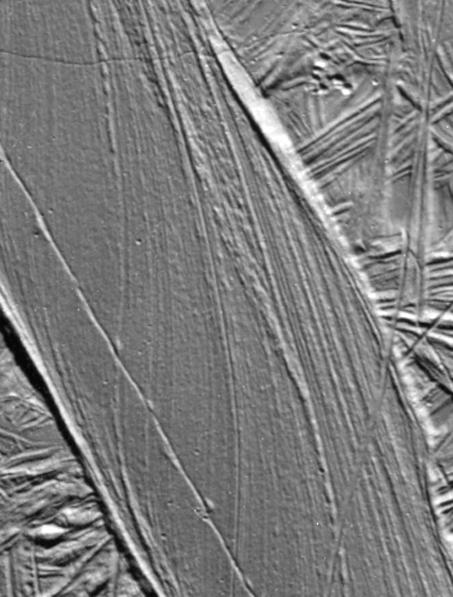All Resources
A Record of Crustal Movement on Europa

This view of the south polar region of Jupiter's moon Europa shows part of a gray band that formed as plates on the icy surface separated and material filled in the widening gap. North is to the top of the picture. In the center of the image, a gently curving linear crack runs north to south and appears to be the location where the fault originally opened. Successive layers, like tree rings, form as material enters the gap periodically from below and hardens.
The relative motion of the two opposing sides of the band is mostly "strike-slip," where two crustal blocks move horizontally past one another, similar to two opposing lanes of traffic. However, since this motion is not exactly parallel to the active crack, the opposite sides also pull apart to create openings through which warmer, softer ice from below Europa's brittle ice shell surface, or frozen water from a possible subsurface ocean, could reach the surface. The band surface accumulates layer by layer. A rough symmetry with respect to the active central linear crack can be seen in these layers.
The large, segmented crack paralleling the west (left) side of the band cuts the original north to south fault shown in the center of the image. This suggests that the central fault has not been active since the large, segmented crack formed.
The curved, lined area is a small part of a much larger strike-slip fault called Astypalaea Linea. This fault extends over 500 miles (800 kilometers), roughly the distance of the portion of California's San Andreas fault from the Mexican border to the San Francisco Bay. Galileo images show that the Europan fault has slipped about 30 miles (50 kilometers).
The Sun illuminates the surface from the top. The image, centered at 66 degrees south latitude and 195 degrees west longitude, covers an area approximately 15 by 10 miles (24 by 16 kilometers). The resolution is 131 feet (40 meters) per picture element. The images were taken on Sept. 26, 1998 at a range of less than 2,600 miles (4,200 kilometers) by Galileo's solid-state imaging system.


